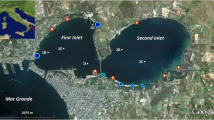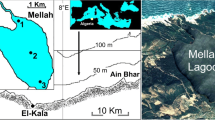Abstract
The first observation of a red tide of the toxic dinoflagellate Alexandrium tamarense in the Yodo River estuary, Osaka Bay, Japan was in the spring of 2007. To clarify which environmental factors controlled the abundance of A. tamarense, field surveys were conducted in 2008 and 2009. In 2008, the increase of A. tamarense occurred from early to mid-March and temperatures ranged from 9 to 13 °C. In contrast, in 2009, the increase was 1 month later, from early to mid-April and therefore temperatures were higher. In both years, A. tamarense was most abundant when salinities were relatively high (15–25), river discharge was low, and the water column was stable. There were no cells during periods of low salinity (<10), high discharge. In 2008, possibly silicate and phosphate were limiting during the simultaneous diatom and A. tamarense bloom in early March with silicate restricting the further growth of diatoms. In this estuarine basin, freshwater discharge from the weir increased the flow rate at stations downstream of the weir and deterred bloom formation by A. tamarense. Conversely, the lack of discharge increased the salinity and stability of the water column and decreased in the flow rate in the river/estuary. This process promoted the initiation of the bloom of A. tamarense and the subsequent accumulation of paralytic shellfish toxin in the brackish water clam Corbicula japonica. It is recommended that a constant discharge from the weir is maintained in order to prevent blooms of A. tamarense and subsequent paralytic shellfish poisoning (PSP) incidents in this area.








Similar content being viewed by others
References
Anderson DM, Alpermann TJ, Cembella AD, Collos Y, Massert E, Montresor M (2012) The globally distributed genus Alexandrium: multifaceted roles in marine ecosystems and impacts on human health. Harmful Algae 14:10–35
Conway HJ, Harrison PJ (1977) Marine diatoms grown in chemostats under silicate or ammonium limitation. IV. Transient response of Chaetoceros devilis, Skeletonema costatum, and Thalassiosira gravida to a single addition of the limiting nutrient. Mar Biol 43:33–43
Fauchot J, Levasseur M, Roy S, Gagnon R, Weise AM (2005) Environmental factors controlling Alexandrium tamarense (Dinophyceae) growth rate during a red tide event in the St. Lawrence estuary (Canada). J Phycol 41:263–272
Fauchot J, Saucier F, Levasseur M, Roy S, Zakardjian B (2008) Wind-driven river plume dynamics and toxic Alexandrium tamarense blooms in the St. Lawrence estuary (Canada): a modeling study. Harmful Algae 7:214–227
Franks PJS, Anderson DM (1992) Alongshore transport of a toxic phytoplankton bloom in a buoyancy current: Alexandrium tamarense in the Gulf of Maine. Mar Biol 112:153–164
Hamano Y, Kawatsu K, Tsukamoto T (2002) Occurrence of paralytic shellfish toxins in bivalves collected in Osaka Bay. Bull Osaka Pref Inst Pub Health 40:11–18 (in Japanese)
Horwits W (ed) (2000) AOAC, Official Method 959.08 Paralytic Shellfish Poison, biological method. In: Methods of analysis of the Association of Official Analytical Chemists, 17th edn. AOAC International, Gaithersburg, MD, pp 59–61
Ichimi K, Yamazaki M, Suzuki T (2000) Horizontal and vertical distributions of cysts of Alexandrium spp. in the sediments of the northeast coastal area, Miyagi Prefecture Japan. Bull Tohoku Natl Fish Res Inst 63:119–124 (in Japanese)
Imai I, Yamaguchi M, Hori Y (2006) Eutrophication and occurrences of harmful algal blooms in the Seto Inland Sea, Japan. Plankton Benthos Res 1:71–84 (in Japanese)
Itakura S, Yamaguchi M, Yoshida M, Fukuyo Y (2002) The seasonal occurrence of Alexandrium tamarense (Dinophyceae) vegetative cells in Hiroshima Bay, Japan. Fisheries Sci 68:77–86
Kawatsu K, Hamano Y, Sugiyama A, Hashizume K, Noguchi T (2002) Development and application of an enzyme immunoassay based on a monoclonal antibody against gonyautoxin components of paralytic shellfish poisoning toxins. J Food Prot 65:1304–1308
Paashe E (1973) Silicon and the ecology of marine plankton diatoms. II. Silicate-uptake kinetics in five diatom species. Mar Biol 19:262–269
Prakash BA (1967) Growth and toxicity of a marine dinoflagellate, Gonyaulax tamarensis. J Fish Res Bd Can 24:1589–1606
Sakai M (2010) Remarkable contaminations by paralytic shellfish poisoning in Tokushima, Japan. Tokushima Pref AgrForest Fish Tec Support Center Report 74:5–6 (in Japanese)
Shimada H, Sawada M, Kuribayashi T, Nakata A, Miyazono A, Asami H (2010) Spatial distribution of the toxic dinoflagellate Alexandrium tamarense in summer in the Okhotsk Sea off Hokkaido, Japan. Plankton Benthos Res 5:1–10
Tanaka Y (1984) Salinity resistance of the brackishwater clam Corbicula japonica. Bull National Res Ins Aqua 6:29–32 (in Japanese)
Tarutani K, Yamamoto T (1994) Phosphate uptake and growth kinetics of Skeletonema costatum isolated from Hiroshima Bay. J Fac Appl Biol Sci Hiroshima Univ 33:59–64 (in Japanese)
Therriault JC, Painchaud J, Levasseur M (1985) Factors controlling the occurrence of Protogonyaulax tamarensis and shellfish toxicity in the St. Lawrence estuary: freshwater runoff and stability of the water column. In: Anderson DM, White AW, Baden DG (eds) Toxic dinoflagellates. Elsevier, New York, pp 141–146
Townsend DW, Pettigrew NR, Thomas AC (2005) On the nature of Alexandrium fundyense blooms in the Gulf of Maine. Deep Sea Res II 52:2603–2630
Uchida T, Toda S, Nakamura O, Abo K, Matsuyama Y, Honjyo T (1998) Initial site of Gymnodinium mikimotoi blooms in relation to the seawater exchange rate in Gokasyo Bay, Japan. Plankton Biol Ecol 45:129–137
Weise A, Levasseur M, Saucier F, Senneville S, Bonneau E, Roy S, Sauve G, Michaud S, Fauchot J (2002) The link between precipitation, river runoff, and blooms of the toxic dinoflagellate Alexandrium tamarense in the St. Lawrence. Can J Fish Aquat Sci 59:464–473
Yamamoto K (2004) Occurrence of paralytic shellfish toxins in the spring of 2002 in east side of Osaka Bay. Bull Osaka Pref Fish Exp St 15:1–8 (in Japanese)
Yamamoto T, Tarutani K (1997) Effects of temperature, salinity, and irradiance on the growth of toxic dinoflagellate Alexandrium tamarense isolated from Hiroshima Bay, Japan. Jpn J Phycol 45:95–101 (in Japanese)
Yamamoto T, Yoshizu Y, Tarutani K (1995) Effects of temperature, salinity, and irradiance on the growth of toxic dinoflagellate Alexandrium tamarense isolated from Mikawa Bay, Japan. Jpn J Phycol 43:91–98 (in Japanese)
Yamamoto K, Nakajima M, Tabuchi K, Hamano Y (2009) A novel red tide of the toxic dinoflagelalte Alexandrium tamarense and resultant contamination of paralytic shellfish toxins in bivalves in the spring of 2007 in Osaka Bay. Bull Plankton Soc Japan 56:13–24 (in Japanese)
Yamamoto K, Ohmi H, Sano M (2011) Occurrence of a red tide of the toxic dinoflagellate Alexandrium tamarense in the estuary of the Yodo River in 2007—dynamics of the vegetative cells and the cysts. Bull Plankton Soc Japan 58:136–145 (in Japanese)
Yoshida M (2000) The taxonomic study of the genus Alexandrium. Ph.D. Thesis, The University of Tokyo, Tokyo (in Japanese)
Acknowledgments
We thank colleagues at Marine Fisheries Research Center, Research Institute of Environment, Agriculture and Fisheries, Osaka, Prefecture for their helpful comments. We also thank Ms. Tamura of Yodogawa River Office, the Ministry of Land, Infrastructure, Transport and Tourism Japan for providing outflow rate data from the weir and topographic data. We are grateful to Dr. Nishikawa at Tajima Fisheries Technology Institute, Hyogo Prefectural Technology Center for Agriculture, Forestry and Fisheries for the valuable advice and useful comments.
Author information
Authors and Affiliations
Corresponding author
Rights and permissions
About this article
Cite this article
Yamamoto, K., Tsujimura, H., Nakajima, M. et al. Flushing rate and salinity may control the blooms of the toxic dinoflagellate Alexandrium tamarense in a river/estuary in Osaka Bay, Japan. J Oceanogr 69, 727–736 (2013). https://doi.org/10.1007/s10872-013-0203-7
Received:
Revised:
Accepted:
Published:
Issue Date:
DOI: https://doi.org/10.1007/s10872-013-0203-7




